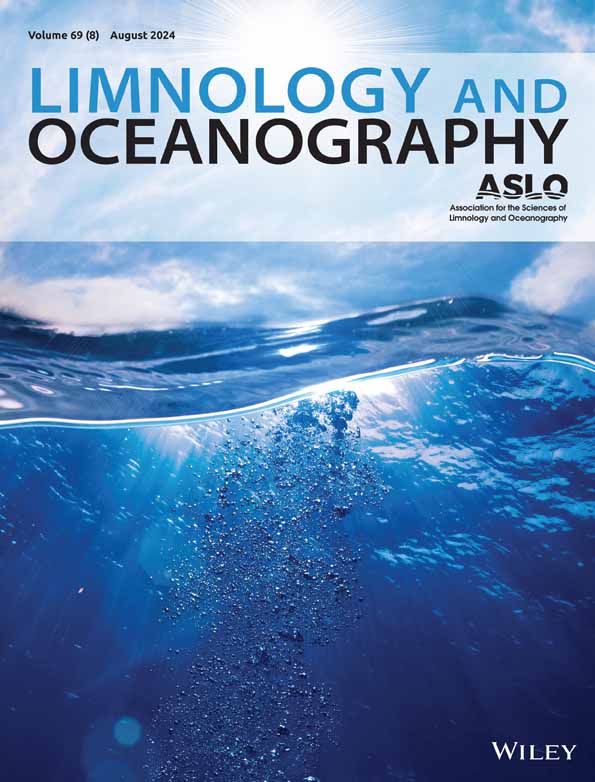排放和养分相互作用决定湿地的营养结构:来自景观尺度操纵的证据
IF 3.7
1区 地球科学
Q1 LIMNOLOGY
引用次数: 0
摘要
对于对营养和干旱敏感的受管理淡水生态系统来说,确定消费者生物量模式和群落结构的驱动因素是复杂的。在佛罗里达大沼泽地,流量恢复有望在广阔的湿地上重新引入流量,但大多数关于消费者的研究都集中在水深和干扰动上。低速水流可以调节基础食物资源的营养有效性,但其对消费者群体的放大效应在很大程度上尚未得到验证。我们量化了消费者对景观尺度的流量操纵的反应,该流量操纵沿着2.5公里的相互连接的浅泥沼路径产生了流量变化。在4年多的时间里,我们在26个沼泽中反复取样大型无脊椎动物、小鱼和大型掠食性鱼类(标准长度为8厘米),其中一些沿着水流路径经历脉冲水释放,另一些在两个非流动参考区域。我们测试了预先排放对消费者生物量的影响,同时考虑了当地的养分浓度(总磷)。排放增加了所有消费群体的生物量,特别是在寡营养污泥中。相反,富营养化污泥对小鱼和大型无脊椎动物表现出更强的自上而下效应,其排放主要有利于大型掠食性鱼类。营养梯度优先增加了大型鱼类,并导致大型无脊椎动物群落向草食性和可能的捕食抗性类群转移。结构方程模型同样表明,在富含养分的污泥中,排放具有自下而上的支持作用,但自上而下的控制作用更强。这些发现表明,排放和总磷相互作用产生不同的消费者生物量模式。据推测,低营养沼泽地沼泽的流量恢复可以提高各营养水平的水生消费者生物量,揭示了以前未认识到的慢流生态系统的生态效益。本文章由计算机程序翻译,如有差异,请以英文原文为准。
Discharge and nutrients interact to determine trophic structure in a wetland: Evidence from a landscape‐scale manipulation
Identifying drivers of consumer biomass patterns and community structure is complex for managed freshwater ecosystems that are sensitive to nutrients and drought. In the Florida Everglades, flow restoration is expected to reintroduce discharge across an expansive wetland, yet most research on consumers has focused on water depth and dry disturbances. Low‐velocity flow can mediate nutrient availability for basal food resources, but its scaled‐up effects on consumer communities remain largely untested. We quantified consumer responses to a landscape‐scale flow manipulation that created discharge variability along a 2.5‐km path of interconnected shallow sloughs. Over 4 yr, we repeatedly sampled macroinvertebrates, small fishes, and large predatory fishes (standard length > 8 cm) in 26 sloughs—some along a flow path experiencing pulsed water releases and others in two non‐flowing reference areas. We tested the effects of antecedent discharge on consumer biomass while accounting for local nutrient concentrations (total phosphorus). Discharge increased biomass across all consumer groups, particularly in oligotrophic sloughs. Conversely, eutrophic sloughs demonstrated stronger top‐down effects on small fishes and macroinvertebrates, with discharge primarily benefiting large predatory fishes. Nutrient gradients preferentially increased large fishes and caused macroinvertebrate community shifts favoring herbivorous and possibly predation‐resistant taxa. Structural equation modeling similarly indicated bottom‐up support from discharge but stronger top‐down control in nutrient‐rich sloughs. These findings demonstrate that discharge and total phosphorus interactively produce distinct consumer biomass patterns. Flow restoration in oligotrophic Everglades sloughs is hypothesized to enhance aquatic consumer biomass across trophic levels, revealing an ecological benefit to slow‐flowing ecosystems not previously recognized.
求助全文
通过发布文献求助,成功后即可免费获取论文全文。
去求助
来源期刊

Limnology and Oceanography
地学-海洋学
CiteScore
8.80
自引率
6.70%
发文量
254
审稿时长
3 months
期刊介绍:
Limnology and Oceanography (L&O; print ISSN 0024-3590, online ISSN 1939-5590) publishes original articles, including scholarly reviews, about all aspects of limnology and oceanography. The journal''s unifying theme is the understanding of aquatic systems. Submissions are judged on the originality of their data, interpretations, and ideas, and on the degree to which they can be generalized beyond the particular aquatic system examined. Laboratory and modeling studies must demonstrate relevance to field environments; typically this means that they are bolstered by substantial "real-world" data. Few purely theoretical or purely empirical papers are accepted for review.
 求助内容:
求助内容: 应助结果提醒方式:
应助结果提醒方式:


